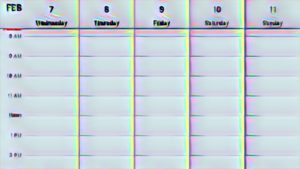
A couple of people to whom I’ve shown a crochet work in progress or a finished craft project have said to me, “I don’t know how you make time to craft!” And while I wish I had the power to stop time, I do not. I have the same number of hours as everyone else. But I haven’t always been able to figure out how to use them for creative work. When I decided for sanity reasons I needed to “make” time to craft, I made a schedule prioritizing it. I was able to make time to craft by making it a priority. “Make it a priority” sounds simple, but it involves doing some work figuring out what gets in the way of actually spending time doing what you want to do.
I’m not a professional time organizer or efficiency expert. But I do have experience with things that work and things that don’t work. Here, I give eight tips for managing your crocheting, cooking, crafting, or other creative time. You can do these actions as formally or informally as you want. Write lists, schedules, and declarations or do each step in your head instead. These tips help with carving out some time to do creative work, but they also help you understand how you use your time
Tip 1: Decide you need creative time in your day

You’re here reading this post, so maybe you have decided that you need dedicated time for creating. Not long ago, I wanted craft time in my day, but it hadn’t occurred to me to declare that I needed it. I thought about it all the time. I pinned crochet patterns, bought pens at the art supply store, organized my craft supplies, and talked about what I would work on when I had the time. But time doesn’t magically show up. Other tasks and demands will always fill your time unless you designate it for creative endeavors.
One day, I decided that crafting was not a luxury. It is part of what makes me feel like my best self. When I shared that with my husband Stephen, he understood and supported my decision to carve out time to create. I had taken the first step toward having crafting time! Then I needed to figure out how to make it happen.
Tip 2: Assess how you spend your time now
We all use our 24 hours for something. We might be working, commuting, sleeping, eating, or watching television. All of us already do something during those 24 hours. We can’t go to the time store to get more time. We have to change how we use some of it to “get more.” In the past, I usually pushed bedtime later to do whatever I needed to do. My friends frequently heard me say, “I stayed up all night” during college and graduate school. As I got older, my body began objecting to this practice. I had to find a different way to get more time. That meant assessing how I use my time during the day.
What activities take up your time now? Work? Picking up kids from school? Fixing dinner? Watching the news? Eating breakfast? What things can you move to a different time? What things can you hand off to someone else? Can you cut anything out? By shifting things around a bit, can you find about 45 minutes to an hour each day to set aside?
For me, inflexible time consists of work from 8am to 5pm. I put Benjamin (our 2-year old) to bed around 7:30. And I like going to bed at the same time as Stephen. Flexible time includes my lunch and breaks at work, the time between dinner and putting Benjamin to bed, and whatever time I might have before getting in the shower at 6:15am.

Tip 3: “Make” your creative time
Once you figure out what you spend your time doing, how long things take, and what things you can’t budge, you can start shifting things around, handing off tasks and activities, cutting out things that take your time unnecessarily, and combine activities to create a block of time for creating!
Shift Activities
Once you figure out what you spend your time doing now and how flexible that time is, you can start shifting, reassigning, cutting, and blocking it. I played around with the idea of getting back up after Stephen went to sleep and working on projects then, but I didn’t like how lonely it felt to get back up after we had gone to bed. In the end, I found the most flexible time in the morning. Instead of staying awake for an hour or so after we go to bed, I sleep then and get up extra early to work on crafts. It doesn’t always work, but most mornings I can set the alarm for 4:05 and be up by around 4:20. I’m still trying for a consistent 4:00am. If I do that, I have about an hour and 10 minutes to work on projects or write.
By shifting the time I started sleeping, I made it possible to get up earlier in the morning and still get (nearly) enough sleep. No one else in the house wakes up this early, so I don’t miss out on time with Stephen or with Benjamin. I have always found I can be most productive in the morning, I just haven’t always been good about making use of that time.
Hand off Activities
If you have a block of time that would be perfect for creative work, but you have to stop and fix dinner in the middle of it, perhaps you can hand off fixing dinner to your partner or someone else in your house? Stephen gets Benjamin ready in the morning. This allows me to finish getting ready, which means I can start getting ready for work later in the morning. That lets me craft for about 20 minutes longer.
Talk things over with your partner. They might have ideas for how they can help make you some crafting time.
Cut Activities
Even with shifting and handing off activities, you still might have to cut some things out. I found I could cut out most games I played on my phone. Really, playing another round of solitaire does not make my life better, no matter how compelled I feel to move those little electronic cards around. I have also cut out almost all television watching. Sure, I might sit down with Stephen to watch a few minutes of the news after I put Benjamin to bed. Or maybe I’ll pull out a crochet project and do some stitching while the three of us watch the Seahawks or view Harry Potter: Prisoner of Azkaban for the millionth time, but other than that, I try to spend the extra time I find making something.
While I don’t write a blog post or complete a crocheted scarf in the time I used to play solitaire, I can look at Pinterest, spend some time chatting with Stephen, or start a load of laundry instead. This means that the blocks of time I dedicate to crafting aren’t taking as much time away from my family or other tasks I need to accomplish.
Combine and consolidate activities
Some multitasking doesn’t work. Sometimes I just want to melt into a mindless television show or get caught up in a suspenseful one. When I’m really into a suspenseful program, I forget to pay attention to how I started a crochet row or how many stitches I’ve completed. Combining crafts and The Blacklist doesn’t work very well for me. However, combining the treadmill and suspenseful episodes has made it easier to exercise and to cut out the rest of my television watching. Instead of those two things taking two hours, together they take one hour.
Consolidating activities helps save time for more crafting. On Sunday night, I try to make a salad and pack it into five containers to take to work with me during the week. If I do this, then packing my lunch consists of grabbing a few containers and an apple out of the fridge on my way out the door. If I don’t do this, I have to spend time packing something to eat each morning, which takes away from my morning creativity time. Making five salads takes about the same time as making one. Do a job once for the week instead of five times.

Tip 4: Develop a routine that works
Having a routine helps ensure you continue to have the time you set aside for creative work. “Sometime in the morning” might not work if other things need to get done in the morning too. Setting specific start and end times helps me protect that time from getting filled with other things. Stephen knows that between 4am and 5:15am I’ll be crocheting, beading, journaling, unraveling, or writing. He doesn’t ask me to do other things with that time.
I established workable, protectable time by backward engineering my morning routine. The process started with what time we needed to leave the house: 7:25-7:30. I wrote down how long I wanted to spend eating breakfast, how long it takes me to shower and dress, and how long it takes for Stephen and me to get Benjamin ready. Once I knew those things, I figured out start and stop times for each step of the morning. And I built in a little wiggle room. I’m amazed at how smoothly the mornings go when I stick to this routine.
Work and a two-year-old pretty much determine the rest of my day’s schedule. Instead of fighting that, I work within the parameters of work, dinner, playing, bath time, and bed time. I might sneak in some crafting while playing with Benjamin, but I don’t expect to craft then. But because I know I can craft in the morning, I can play more presently.
Tip 5: Establish boundaries
To successfully make time to craft, establish an effective work/home boundary. I’m lucky enough to have a job now where I do all of my work at work and do not take any of it home. The nature of my work enforces the work/home boundary, which is lovely. When I was a professor, I was terrible at this. I brought work home, didn’t use my time efficiently, and always had work to do. This meant I could never justify crafting time. I always said something like, “when these papers are graded, I can get out my yarn.” I never made it happen. Home time and work time were pretty much the same, and I couldn’t crochet at work. Once I had a work/home boundary, I had much more control over how to use my time at home. What a concept!
If you do have a job that allows you to take your work home, my advice is: don’t. It’s great to be able to catch up on your email in your jammies, but the trade off is that your boundaries suffer. Some people are able to work from home and maintain these lines. If you can do this, please let me know in the comments what kinds of strategies you use to maintain your work/home boundaries. I am so much happier with my boundaries in place. And I think I’m better at my job now that I’m only working at work and being at home when I’m at home.
In addition to work/home boundaries, making it clear to others that your creative time is not frivolous will help you maintain the boundaries around your scheduled time. That brings us to the next tip.
Tip 6: Enlist your family
Schedules go off track all the time. But when everyone knows the routine and expectations, schedules have a better chance of working. Enlisting your partner, kids, or roommates in helping you stick to your schedule will give you accountability and encouragement. It will also help emphasize how important this time is to you.
Announce to your partner, your family, or your roommates that you intend to set aside some time for creativity. Explain that it is important to you and that it’s not frivolous or free time that can be intruded upon. Making it a priority for yourself means that you stake out that time so others don’t swoop in and make demands on it.
One of the biggest reasons to set aside time to create is so you don’t try to multitask all the time you have with the people you love. Now that I have dedicated craft time, I don’t worry about crocheting while I’m putting together a duplo car with Benjamin. I feel more present when spending time with my family because I got some crafting time in already that day.

Tip 7: Use your snatches of time
My mom used to teach a course in study skills to high school students. I remember her talking about “using your snatches of time.” For some people, snatches of time might show up in that awkward 15 minutes between when you get home and when you need to start fixing dinner. For others, you might find a snatch of time standing in a long line at Costco. We can’t use all of these snatches for creative work. Maybe you quilt and didn’t bring your sewing machine with you to Costco. But some of those times lend themselves nicely to getting a few rows crocheted on a scarf or affixing pictures to a scrap book page. And snatches of time don’t replace your dedicated time, they’re just bonus.
For me, snatches of time occur in the car on the way to the grocery store (if Stephen is driving). They occur in short bits in the evenings if I get Benjamin down to bed quicker than usual. They occur during lunch breaks at work. I try to have a small crochet project with me to work on during those snatches of time.
Having projects at the ready for those snatches of time helps. This means being organized enough to grab your yarn, paper, or beads and work on that project you’ve got going. In the coming weeks, I’ll be discussing craft space and organization. Staying organized and having your materials accessible helps you make the best use of your snatches of time.

Tip 8: Adjust when the schedule stops working
Sometimes circumstances change. Maybe soccer practice changes to a new time or your work schedule changes. You may be able to make small adjustments or you may need to go through the process again. Either way, making crafting and creative time a priority means reassigning it time in your routine even when your routine has to change.
A few months ago, the combination of having a desk job and getting older prompted me to start a modest but committed exercise regimen. Because I had already discovered mornings worked for me, I decided to get up just a little earlier and work out before my craft time. I did get up and I did exercise. But I ran into the problem of not feeling like crafting once I was sweaty and tired. However, I persisted. For about two months. It still didn’t work. I got into the habit of working out every morning, which is great, but I didn’t do as much crafting.
Finally, I reassessed. The exercise needed to happen. And I definitely needed to craft. I had a chunk of useable time…What if I had crafting time and then did my workout? I tried doing that. And it worked! I’m more motivated to get up early because I get to start with crafting and I know I need to stop by 5:15 so I can get my workout done by 6:15.
As I write this, I need to reassess again. I have struggled with scheduling writing time the last couple weeks. Once I figure out how to schedule my writing time effectively, I’ll update!

Share your tips on how you make time to craft!
What have you found works for making time to create? Do you have any tips to share? I feel like we can all learn from and be inspired by each other! Share your tips and stories in the comments!


Great information. Lucky me I found your site by accident
(stumbleupon). I’ve bookmarked it for later!
When someone writes an piece of writing he/she keeps the thought
of a user in his/her brain that how a user can understand it.
So that’s why this post is outstdanding. Thanks!
If you wish for to grow your know-how simply keep visiting this web site and
be updated with the newest news update posted here.
I know this if off topic but I’m looking into starting
my own blog and was wondering what all is needed to get set up?
I’m assuming having a blog like yours would cost a pretty penny?
I’m not very internet smart so I’m not 100% sure. Any suggestions or advice would
be greatly appreciated. Cheers